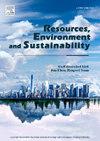畜禽粪便氮、磷、有机质排放特征、影响因素及污染潜力空间分布——以黄河三角洲地区为例
IF 12.4
Q1 ENVIRONMENTAL SCIENCES
引用次数: 0
摘要
黄河三角洲具有海陆相互作用强烈的特点,是一个高度敏感和脆弱的环境。牲畜残留物通过径流和渗透运输,加剧了土壤和水污染,对近海水域构成威胁。因此,减轻与三角洲牲畜残留物相关的环境风险迫在眉睫。本研究将现场测量与模型分析相结合,为畜禽粪便污染控制提供新的见解。它审查了土壤和水生环境的排放特征,并评估了污染潜力的空间分布。黄河三角洲地区畜禽粪便中总氮和总磷含量分别超过生态环境部规定的3-6倍和7.2倍。大规模养殖主要通过增加冲洗来减少污染物负荷。缩短农场和河流之间的距离,以及采用湿式清洁方法,减轻了氮、磷和有机物污染的风险。与厌氧消化相比,好氧堆肥降低了粪肥中的污染物水平,但增加了泥浆中的有机物含量。农田附近土壤污染严重,总氮和有机质浓度分别是农田至河流垂直样带土壤污染的2.0和2.1倍,而水体污染相对较好。非点源污染高发区主要集中在黄河三角洲西北部和南部。即使是低风险的水道,如黄河和仙仙沟,也对渤海构成潜在威胁。优化养殖规模、冲洗强度、粪便清洗和处理方法以及农场与河流的距离可以有效降低污染风险。本文章由计算机程序翻译,如有差异,请以英文原文为准。

Characteristics and influencing factors of livestock residue nitrogen, phosphorus, and organic matter discharge and spatial distribution of pollution potential: Case study in the Yellow River Delta, China
The Yellow River Delta, characterized by intense land-sea interactions, has a highly sensitive and fragile environment. Livestock residue, transported through runoff and infiltration, exacerbates soil and water contamination, posing a threat to offshore waters. Thus, mitigating the environmental risks associated with livestock residue in the delta is urgent. This study integrated field measurements and model analysis to provide new insights into livestock residue pollution control. It examined discharge characteristics in soil and aquatic environments and assessed the spatial distribution of pollution potential. In the Yellow River Delta, total nitrogen and total phosphorus levels in livestock residue exceeded the Ministry of Ecology and Environment’s limits by 3–6 times and 7.2 times, respectively. Large-scale breeding primarily reduced pollutant loads by increasing flushing. Shortening the distance between farms and rivers, along with adopting wet cleaning methods, mitigated nitrogen, phosphorus, and organic matter pollution risks. Compared to anaerobic digestion, aerobic composting reduced pollutant levels in manure but increased organic matter in slurry. Soil pollution was severe near farms, with total nitrogen and organic matter concentrations 2.0 and 2.1 times higher than those along the vertical transect from farms to rivers, while water pollution was relatively benign. High-risk non-point source pollution areas were concentrated in the northwest and south of the Yellow River Delta. Even low-risk waterways, such as the Yellow River and Xianxian Ditch, posed potential threats to the Bohai Sea. Optimizing breeding scale, flushing intensity, manure cleaning and treatment methods, and farm-river distances can effectively reduce pollution risks.
求助全文
通过发布文献求助,成功后即可免费获取论文全文。
去求助
来源期刊

Resources Environment and Sustainability
Environmental Science-Environmental Science (miscellaneous)
CiteScore
15.10
自引率
0.00%
发文量
41
审稿时长
33 days
 求助内容:
求助内容: 应助结果提醒方式:
应助结果提醒方式:


